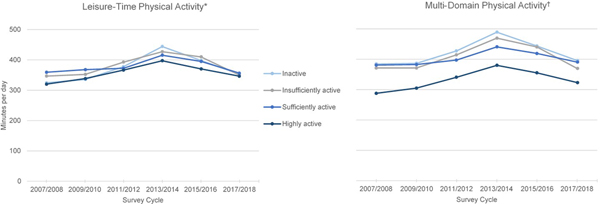Figure 2. Trends in mean daily sitting time among US adults by levels of leisure-time and multi-domain physical activity, NHANES 2007/2008 to 2017/2018.
* For leisure-time physical activity, respondents reported the frequency (days per week) and duration (minutes per day) of vigorous- and moderate-intensity “sports, fitness and recreational activities” done for at least 10 minutes continuously in a typical week. The frequency and duration of moderate- and vigorous-intensity activity were multiplied to calculate total weekly volume. Per aerobic physical activity guidelines, the volume of vigorous-intensity physical activity was multiplied by two and added to moderate-intensity activity to create moderate-intensity equivalent minutes. Based on the volume of moderate-intensity equivalent minutes of leisure-time physical activity, each respondent was categorized as inactive (<10 minutes per week), insufficiently active (10–149 minutes per week), sufficiently active (150–300 minutes per week), or highly active (>300 minutes per week).
† Includes leisure-time, occupational/household, and transportation-related physical activity. For occupational/household physical activity, respondents reported the frequency (days per week) and duration (minutes per day) of vigorous- and moderate-intensity activities done as part of “paid or unpaid work, household chores, and yard work” for at least 10 minutes continuously in a typical week. For transportation-related physical activity, respondents reported the frequency (days per week) and duration (minutes per day) of “walking or using a bicycle for at least 10 minutes continuously to get to and from places” in a typical week; transportation-related activity was considered moderate-intensity. Within each domain, the frequency and duration of moderate- and vigorous-intensity activity were multiplied to calculate total weekly volume. Per aerobic physical activity guidelines, the volume of vigorous-intensity physical activity was multiplied by two and added to moderate-intensity physical activity to create moderate-intensity equivalent minutes. Based on the combined volume of moderate-intensity equivalent minutes of leisure-time, occupational/household, and transportation-related physical activity, each respondent was categorized as inactive (<10 minutes per week), insufficiently active (10–149 minutes per week), sufficiently active (150–300 minutes per week), or highly active (>300 minutes per week).

